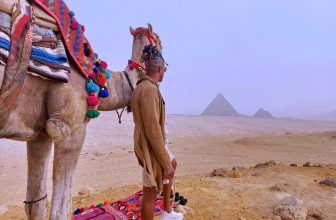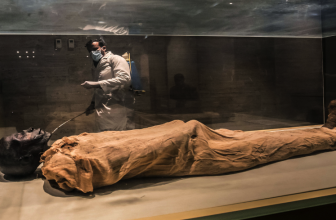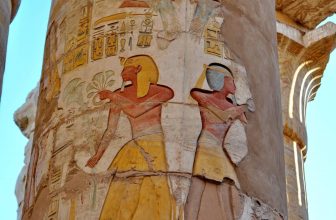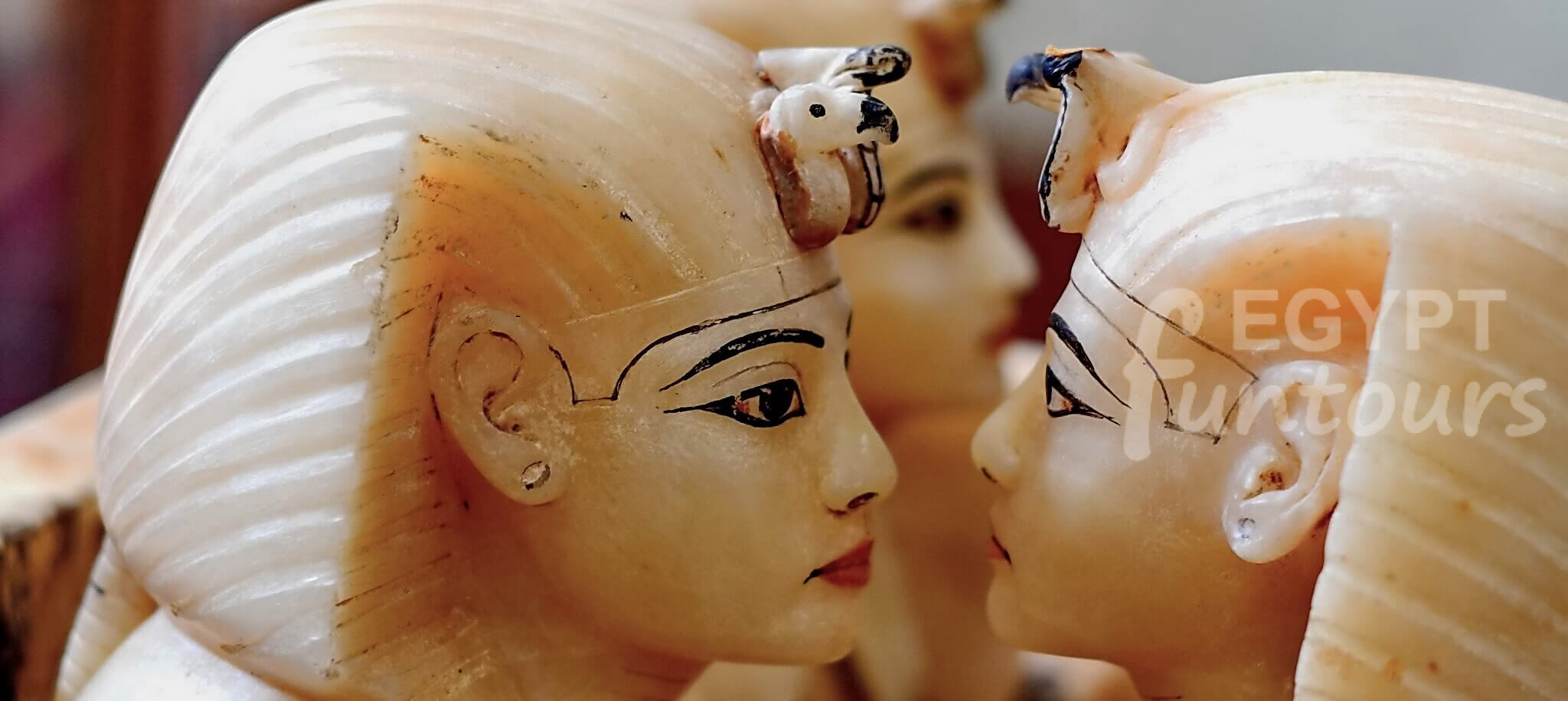Egypt’s ancient center for the cult of Isis, the Temples of Philae were venerated from the Pharaonic era through the Greek, Roman, and Byzantine periods with each ruler making their own additions to the stones here. This sacred site has dazzled travelers since the first Nile cruises set off from Cairo, and is one of Nubia’s most important monument sites.
The temples were saved from a watery grave by UNESCO’s rescue operation when the Aswan High Dam was being built and was moved block by block from their original location on Philae Island to Agilika Island, 12 kilometers south of Aswan. As a result, visitors may still stroll among the columns of this historically revered monument today. This is one of Aswan’s most prominent tourist attractions. Use our visitor’s guide to the Philae Temple Complex to help you navigate the site.
First Pylon: The Temple Entranceway:


The Temple Entranceway goes into the main temple area via the First Pylon. It has a majestic 18-meter-high entrance with reliefs by Nectanebo thanks to its two towers and central entryway. The Birth House is reached by a doorway in the western tower with reliefs by Philometor. Two granite obelisks and two granite lions once stood in front of the pylon, built by Euergetes II.
An beautiful entrance adjoins the east tower, with reliefs by Ptolemy II Philadelphus (on the lintel) and Emperor Tiberius (on the jambs). Philadelphus’ gateway was originally constructed within a masonry wall.
Don’t Miss: Many tourists speed past this section on their way to the temple’s interior areas, but it’s worth pausing to see some of the beautiful decorations on the pylon.
A massive relief on the façade of the east tower portrays Ptolemy XII Neos Dionysos grabbing a band of opponents by the hair and smiting them with his club, with Isis, Edfu’s falcon-headed Horus, and Hathor on the left.
Neos Dionysos presents the crowns of Upper and Lower Egypt to Horus and Nephthys (right) and offers incense to Isis and Harpocrates in the reliefs above (left).
Forecourt: The Temple’s Main Courtyard:
Look for the French inscription (“an 7 de la République”) on the right as you enter through the central entryway, commemorating Napoleon’s campaign and General Desaix’s pursuit of the Mamelukes in 1799.
Structures fronted by colonnades may be found on each side of the Forecourt. The priests’ quarters were in the tiny structure to the east, which had some scientific purpose. In the entrance, look for the plant columns, which are remarkable for their beautiful proportions. A entrance on the north side of the building’s entryway leads to the temple’s inner corridor.
The Birth House (Mammisi) is a structure dedicated to Hathor-Isis in celebration of the birth of her son Horus on the western side of the Forecourt.
Colonnades encircle it on all four sides, with foliage caps topped by sistrum capitals on the columns. Reliefs and inscriptions, primarily by Euergetes II, Neos Dionysos, Augustus, and Tiberius, are adorning the walls, columns, and screens between the columns.
Not to be missed: In the Birth House, look for the reliefs in the final room, which represent events from Horus’ youth, including Horus as a falcon in the Delta wetlands and Isis suckling Horus in the swamps.
Second Pylon: Entry to the Inner Temple:
With a majestic 32-meter-wide and 12-meter-high entryway, the Second Pylon gives an appropriately royal entrance to the temple’s inner sanctuary.
Euergetes II created the reliefs on the central entryway. The ruins of a tiny chapel may be seen in front of the entryway. There are some faded early Christian paintings within the central entryway (on the right, above).
Don’t miss: A relief of Neos Dionysos dedicating the killed sacrifice animals to Horus and Hathor may be seen on the lower section of the entryway.
Two tiny reliefs may be seen above. The king is portrayed on the right giving a garland to Horus and Nephthys, and on the left, offering incense to Osiris, Isis, and Horus while pouring water on the altar.
Vestibule: Entering the Inner Temple:
The Vestibule, with its eight columns, is the first room in the inner temple area, and was originally divided from the court by screens between the front columns.
Look for the Coptic crosses and Greek inscriptions carved into the walls, which reveal how the temple was converted into a Christian house of worship under the Coptic Bishop Theodore during the early Byzantine period.
Also, check above the entrance for an inscription honoring Pope Gregory XVI’s archaeological trip to Philae in 1841.
Don’t Miss: The reliefs in the Vestibule were left incomplete and are now ruined, yet they are nonetheless fascinating.
The top relief above the door in the south wall depicts Horus seated on a bench, with Nephthys and Isis giving the Lower and Upper Egyptian crowns. Thoth (left) and Seshat (right), the goddess of writing, inscribe the king’s name on a palm branch, as the air deity Shu, holding a sail, stands behind Thoth.
The reliefs below represent Osiris’ tomb at Abaton, with Osiris’ body carried by a crocodile.
Unfinished reliefs to the left of the entrance depict the monarch giving land gifts, while three lines in Meroitic cursive writing are above.
The Nile’s source is shown in a renowned relief on the right-hand wall (second top row): the deity of the Nile, with a serpent coiled around his body, pours water from two jars beneath a rocky cliff on which sit a vulture and a falcon. To the right of this, Hathor (left) and Isis, Nephthys, Horus, and Amun worship Osiris’ soul in the shape of a bird within the holy grove (right).
The Sanctuary (holy of the holies): House of Isis:
You arrive at the Sanctuary, which is lighted by two small windows after traveling through a series of antechambers bordered by gloomy side rooms.
The holy barque holding the figure of Isis would have been supported by the granite base (given by Euergetes I and his wife Berenice).
A tiny room to the left of the first antechamber has reliefs depicting the king in the presence of Isis. A door on the west side of this chamber leads out of the temple and to the Hadrian’s Gate.
Gateway of Hadrian:
The tiny Gateway of Hadrian, located northwest of the Second Pylon and within the ancient enclosure wall of the temple, was erected during the reign of Emperor Hadrian and is adorned with reliefs by Hadrian, Marcus Aurelius, and Lucius Verus.
The entrance likely led to the Sanctuary of Abaton on the nearby island of Bigga, where there was an Osiris Tomb, and so the reliefs are related to Osiris religion.
Hadrian is portrayed on the lintel giving gifts to Osiris, Isis, and Harsiesis, as well as Osiris, Nephthys, and Harendotes.
The sacred relic of Abydos is on the left hand jamb, while the Djed pillar of Osiris is on the right hand jamb (the sacred emblem of Busiris).
Marcus Aurelius is shown in the company of Osiris and Isis on the right side of the doorway, while Marcus Aurelius offers food and flower gifts to Isis on the left side.
History of Philae: A Place of Pilgrimage through the Centuries:
Philae was known in ancient Egypt as Pilak, from whence the Greek and Latin names Philae were derived.
During the Islamic era, it was known to the locals as El-Oasr, or “Castle,” or Geziret Anas el-Wogud, after the hero of one of the “Arabic Nights” tales who tracked down his lover to the island where she had been imprisoned by her father.
The oldest surviving temple structures originate from the reign of Nectanebo I (about 370 BC), when Isis was the primary deity, though Osiris, Nephthys, Hathor, and the cataract gods Khnum and State were also revered.
The Ptolemies built the towering structures that still exist today in the final two centuries BC, and the Roman Emperors built them in the first three centuries AD.
Many inscriptions reveal that in Greek and Roman periods, travelers went to Philae to pay tribute to Isis, the enigmatic and beneficent goddess of healing.
The Nubians remained devoted to the cult of Isis long after Christianity was introduced, and the temples were only closed and some of its chambers changed for Christian worship during the reign of Justinian (AD 527-565). On the island, a Coptic village thrived from then until the arrival of Islam.
Until the first Aswan Dam was built, the island was regarded as one of Egypt’s most attractive locations, attracting a huge number of visitors each year. Following that, it was submerged for the majority of the year, and the temples were only accessible between August and December.
The building of Egypt’s High Dam project threatened to swallow them forever, but they were spared by UNESCO’s major worldwide rescue mission, which took place between 1972 and 1980.
The island of Philae was encircled by a cofferdam, and the space within it was drained; then, on the nearby island of Agilika, a new site was prepared, the temples were split up into parts, which were precisely numbered, and they were re-erected in the same relative locations.
Take note of the gray colour of the lower walls and columns as you wander around the temple. This is the result of their yearly immersion in water during the interval between the two dams.
The towering and wonderfully preserved temples of Philae retain their capacity to astound despite those years of yearly immersion and then being transported stone-by-stone to a whole new site.
Around the Temple of Isis:
Temple of Hathor:
The little Temple of Hathor, constructed by Philometor and Euergetes II in honor of Hathor-Aphrodite, is located 50 meters east of the Temple of Isis.
Augustus added the vestibule and the temple’s sanctuary (which was later demolished).
The main temple room, which has two plant columns in front of it that are attached to the walls by screens, is the finest surviving portion of the construction.
Don’t Miss: The Vestibule’s columns are adorned with delightful reliefs of flute and harp players, Bes with a tambourine, Bes dancing and playing a harp, monkeys playing the lyre, and priests carrying an antelope.
Kiosk of Trajan:


The adorably dinky Kiosk of Trajan, located southeast of the Temple of Hathor on the riverbank, was a favorite subject of prominent English artists during Egypt’s Victorian explorers’ era. It was left incomplete during the Roman Imperial era.
Remnants of the Byzantine Period:
Various Roman and Byzantine relics, including two Coptic churches, the ruins of a monastery, and the ruins of the Temple of Augustus, may be found in the Philae complex’s northern end.
Tips and Tours: How to Make the Most of Your Visit to the Philae Temple Complex:
A regular sound and light show is held at Philae, featuring presentations in English, French, German, and Spanish. Visiting the temple complex at night, when it is illuminated, gives a whole other depth to your visit. This Sound & Light Performance trip includes hotel pickup and drop-off as well as show admission tickets.
The ideal time to visit this famous tourist destination, like many others in Egypt, is early in the morning, shortly after it opens. Because most tourists visit Philae as part of an Abu Simbel day excursion (on the way back), the site is busiest from around midday to 2pm.
Getting to the Philae Temple Complex:
By Abu Simbel Tour Bus: Philae is included in nearly all Abu Simbel day excursion tour bus itineraries. This is a fantastic alternative for people who are short on time, but keep in mind that you will be part of a big throng if you come this way.














